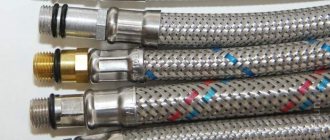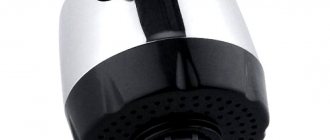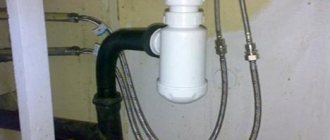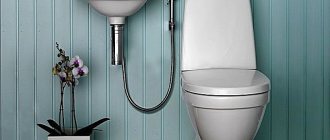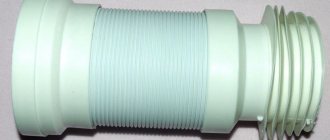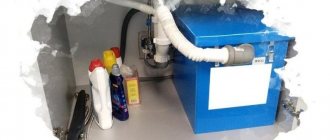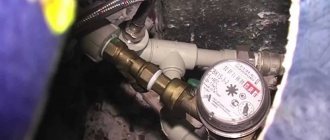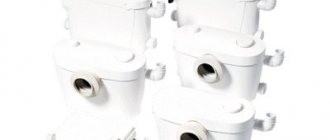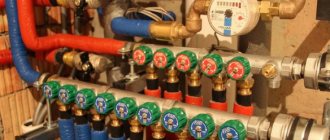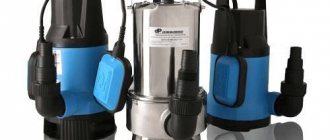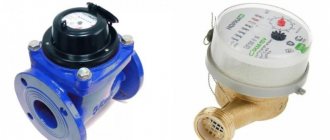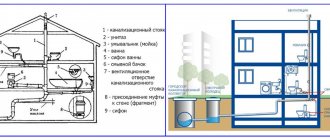To connect water heating equipment, toilets, faucets and other plumbing devices, a liner is required that will connect them to the water supply. This element can have a flexible or rigid design.
Most users prefer the first option. This choice is not made without reason - the flexible connection for the mixer is compact, practical and easy to install. Are you planning to purchase and install such a device, but doubt your own abilities?
We will help you solve this problem. The article describes the features of different types of flexible hoses, indicates the specifics of their application and provides practical advice on choosing the appropriate option. In addition, we have prepared detailed instructions for installing the faucet connection.
Features of flexible plumbing connections
Unlike rigid devices, the liner, equipped with a movable design, can be easily installed in hard-to-reach places with limited space.
Main advantages of the products
During the labor-intensive installation process, steel pipes are bent and secured with clamps, resulting in a bulky metal structure. Installation of a flexible product is much simpler, while the overall quality and reliability of the entire system remains high.
The device is a durable elastic hose with a length of 0.3 to 5 meters. Fasteners with rubber sealing rings are inserted at the ends on both sides.
Flexible eyeliner is often used in interior design solutions. When connected to built-in faucets, it is hidden in a separate block located inside the wall
Typically, well-known faucet manufacturers equip their equipment with this type of connector, which is justified by a huge number of advantages.
Main advantages of the products:
- convenient and safe operation;
- sealed design made of high quality materials;
- the installation/disassembly process is simple for an inexperienced user and does not require specific knowledge, skills and professional equipment;
- resistance to vibrations and the effects of hydraulic shocks that periodically occur in the pipeline;
- long period of serviceable service subject to correct operating conditions;
- maintaining normal performance over a wide temperature range.
If necessary, flexible hoses move freely relative to the mixer and other plumbing fixtures, which cannot be said about their counterparts.
If you perform such manipulations carefully, you do not have to worry about accidental damage to the structure.
Reliable products with appropriate certificates and proper labeling are sold in specialized stores. The accompanying passport describes in detail all the characteristics. The declared service life should not be less than 5 years
Of course, the listed advantages apply only to high-quality products. To purchase a hose with good technical characteristics, you should pay attention to products from reliable brands.
For example, Tucai , Mateu , Uni-Fitt . These manufacturers provide a guarantee for their products and have sanitary permits for contact of devices with drinking water. Among domestic manufacturers, popular companies are Monolit , Flexiline , and Akvatekhnika .
Negative aspects of the device
Elastic hoses, although they are the optimal way to supply water, are not without drawbacks.
Based on the results of the analysis of consumer reviews taken from thematic forums and social networks, the following negative nuances were highlighted:
- products are afraid of excessive twisting, tension, kinks, which provoke irreversible deformation of the structure and greatly reduce the service life;
- if there is an open fire source near the intended installation site, installation of a flexible hose is prohibited;
- When water is simultaneously supplied to several rooms, vibrations occur in the bellows tubes, causing a characteristic hum.
The metal elements present in the device oxidize over time, which leads to the onset of corrosion processes.
When purchasing a product, you need to clarify which plumbing fixtures it will be used to connect to. The connection method depends on this. The sales consultant will show you the types of connections that are suitable for faucets
It should also be taken into account that certain types of flexible liners are sensitive to critical temperatures. Water that is too hot and close to boiling can damage the device, causing unwanted leaks and flooding.
How to connect and when replacement is required
The installation of a flexible water supply to water pipes and plumbing fixtures itself occurs due to the nut and fitting, which are located at different ends of the product.
This process is quite simple, the main thing is that certain rules are followed.
- Before starting installation, it is worth visually assessing the condition of the liner for the quality of the crimp and the presence of defects.
- It is impossible to extend the liner using another hose without using auxiliary fittings. Technically, this is, of course, possible, but then the connections will not be strong and will begin to leak water after a while.
- Do not pull or twist the hose, bend it to the point of breaking or stretch it too much.
- The bending radius of even a very soft underwater hose should not be less than 7 cm.
- Never install the liner under pressure! If the length of the purchased product is not suitable, then it is better to buy a new, longer eyeliner.
- Do not install a flexible hose in a place where it will pass through ceilings. It’s even better not to hang different objects on it and use it near an open fire source.
The old eyeliner should be replaced with another after the period specified in the documentation has expired. Sometimes by that time it is not yet damaged and looks quite strong, but damage may appear on the inside. Sometimes it happens that a pipe begins to rust or leak long before the end of its service life. In this case, you should immediately change it by purchasing products from a reliable manufacturer. Only high-quality materials and the correct manufacturing technology make it possible for a flexible liner to last the entire period allocated to it without problems or breakdowns. To see what you should pay attention to when choosing, watch the video below.
Types of eyeliner: characteristics and specifics of application
Elastic hoses for faucets are divided into two categories: reinforced braided hoses and bellows tubes. Let's look at the features of each type of product in more detail.
Flexible hoses with reinforced braid
The first type of liner is a soft hose with high elastic properties, reinforced with a special braid.
The ends of the tube are equipped with fittings, with the help of which the structure is attached to the mixer: on one side there is a fitting, on the other there is a union nut with a certain diameter of the external thread. Reinforced devices have an affordable price, so they are most in demand among buyers.
Despite the simple production technology, the structure of the hoses is quite complex. The base consists of rubber, rubber or cross-linked polyethylene (PEX).
Experts say that in systems that supply drinking water, the use of rubber hoses is undesirable. The entire length of the product is braided with wire thread. Various materials are used to make braiding.
Stainless steel . The most common type of winding for reinforced hose. It is characterized by optimal operating parameters of the average level: the device functions perfectly within 10 atm. pressure and +95°C of the liquid passing through it. Stainless steel devices operate stably for up to 10 years.
Galvanized wire is a budget option both in terms of price and technical characteristics. Eyeliners made of this material have good flexibility, but they are not strong enough and quickly fail
Nylon . The material has improved performance characteristics. Eyeliners with nylon braid are maximally functional: they can withstand up to +110°C and up to 20 atm. pressure. Their service life significantly exceeds their analogues and is usually at least 15 years.
Aluminum braiding is suitable only for those systems where the water temperature does not exceed +80°C and the operating pressure does not exceed 5 atm. This material is susceptible to corrosion, so it is better to use it in rooms with low humidity. Flexible hoses reinforced with aluminum braid do not require replacement for about 5 years.
Bellows tubes for water
The second type of liner is represented by bellows hoses. The durability and reliability of these models is much higher than reinforced products. The devices are distinguished by their unusual design, which gives them excellent flexibility.
It consists of stainless steel assembled into alternating rings of different diameters. At the initial stages of production, the hose blank is selectively crimped, resulting in a movable corrugated shape.
The bellows liner for water supply can be foldable or have a fixed length. The first option stretches within the range established by the manufacturer: from 200 to 355 mm, from 140 to 250 mm, etc.
Care must be taken when handling collapsible hoses, as excessive stretching will shorten the service life. Fixed length eyeliner cannot be stretched. It is produced in a specifically designated size: from 20 to 80 cm (in increments of 10 cm).
The devices exhibit high resistance to low and high temperature parameters. They work great in the range from -50 to +250 degrees. The service life of bellows tubes reaches 25 years
Bellows hoses have a common disadvantage - noise when supplying water to several consumers at once. The problem is relevant when, for example, water is supplied to the boiler, toilet and faucet at the same time.
To eliminate this, experts recommend choosing a liner with an insulating plastic coating. In addition, there are special anti-vibration modifications that absorb sound.
How to install a faucet with your own hands
- Mixer with fasteners;
- 2 flexible eyeliners;
- rags;
- masking tape;
- adjustable wrench.
Turn off the water
‑channel “220 volts”
Before you begin, close the cold and hot water taps on the sink. If there is no separate shut-off valve on the device, turn off the water on the risers.
Place a clean rag in the bowl to prevent accidental falling parts from damaging the coating.
Remove the aerator
‑channel “220 volts”
Remove the aerator from the spout so that it does not become clogged with rust and other possible contaminants from the pipes. To do this, unscrew it counterclockwise using the plastic wrench included in the kit or a regular adjustable wrench.
The jaws of a metal wrench can scratch the finish of the faucet, so it is better to wrap them with masking tape or a rag.
Assemble the faucet
‑channel “220 volts”
As a rule, plumbing fixtures are supplied already assembled. If any of the elements are not connected, install them according to the instructions. Take the mounting pin from the kit and screw it clockwise until it stops into the hole of the appropriate diameter in the bottom of the mixer.
Connect flexible hoses
‑channel “220 volts”
Attach the flexible hose fittings to the faucet by tightening them by hand. First check that O-rings are installed at the ends of the threads. Do not tighten the fittings with a wrench - excessive force may damage the gaskets.
Reinstall the faucet
‑channel “220 volts”
To prevent water from leaking through the body, place the o-ring in the special groove in the base of the faucet.
First thread one flexible hose into the mounting hole of the sink, and then the second. Place the faucet in the designated location.
Secure the faucet
‑channel “220 volts”
Move under the sink. Place a rubber gasket and a crescent-shaped fastening washer onto the stud. Screw the nut on top and tighten it by hand, and then tighten it with a socket wrench.
Before final tightening, make sure that the faucet is installed without distortion.
Connect to water supply
‑channel “220 volts”
Now place the union nuts of the flexible hoses on the fittings of the water sockets or sink taps and tighten them by hand. Tighten the connections with a wrench, but not too much - half a turn or a little more will be enough.
Don't mix up the hoses! According to the standard, hot water should be on the left and cold water on the right.
Check the operation of the mixer
‑channel “220 volts”
To check and flush the system from possible contamination, open the shut-off valves on the device or risers. Run the water and make sure that when you turn the tap, cold and hot flow as expected.
Install an aerator
‑channel “220 volts”
Return the nozzle to its place by screwing it into the mixer by hand in a clockwise direction. Tighten the aerator just a little with a plastic wrench or a regular adjustable wrench. To avoid scratching the chrome plating, the jaws of the key can be wrapped with masking tape.
Try the faucet
‑channel “220 volts”
Take the eccentric couplings from the kit and screw them into the water sockets in the wall. Wrap the fittings four to five turns so that the distance between their centers is 150 mm.
uralsfs channel
Screw the decorative rosettes on top, and then install the faucet and tighten the union nuts by hand. Make sure there are a couple of threads between them and the covers.
uralsfs channel
Check with a bubble level whether the structure is level and, if necessary, adjust its position by screwing in or unscrewing the eccentrics. Measure the exact distance that the couplings protrude from the wall and note it.
Install eccentrics
uralsfs channel
Disassemble the entire structure to finally assemble it with thread sealing. Wind five or six turns of FUM tape clockwise around the thin ends of the eccentrics. Screw the couplings into the wall to the previously measured depth.
Seal joints
uralsfs channel
To prevent water from getting into the gap between the eccentrics and the wall, fill it with silicone sealant. Squeeze the required amount from the tube and gently spread around the couplings.
Install the faucet
uralsfs channel
Screw decorative rosettes onto eccentrics. Install the gaskets into the union nuts of the faucet, and then attach it to the couplings and tighten the nuts. First by hand, then using a wrench about one turn. Check with a level that the mixer is installed horizontally.
Wrap the wrench jaws with masking tape to avoid damaging the coating on the faucet nuts.
Attach the shower head
uralsfs channel
Install the gasket into the union nut of the hose and screw the part onto the corresponding fitting on the mixer. Attach the second, conical end of the tube to the watering can, also not forgetting about the gasket.
Attach the watering can bracket
‑channel “Repair and decoration”
Estimate at what height the shower holder will be located. Apply masking tape in this place, and then attach the bracket and mark the points for the mounting holes with a pencil.
Use a drill to drill holes. First, with a ceramic drill in the tiles, and then with a concrete drill in the wall. Insert dowels into the holes and secure the holder with screws.
Check the operation of the mixer
uralsfs channel
Open the taps on the cold and hot water risers. Make sure the faucet works in all modes, including shower.
Install an aerator
‑channel “220 volts”
After a small amount of water has drained, do not forget to return the faucet nozzle to its place. Screw the aerator by hand and tighten it 10–20 degrees with the special plastic wrench included in the delivery kit. If you don't have such a tool, wrap the jaws of the adjustable wrench with masking tape and use it.
Source: https://Lifehacker.ru/ustanovka-smesitelya/
Basic criteria for product selection
A few simple recommendations will help you choose a faucet liner that is suitable in all respects and will last for years without any problems.
Before purchasing a product, experts advise:
- Check the compliance of the actual parameters of the operating temperature, pressure in the water supply of an apartment or private house with the technical characteristics of the liner specified on the label and in the manufacturer’s instructions.
- Consider future operating conditions when selecting braiding material. For damp rooms with poor ventilation systems, you should not purchase products with metal braiding. Condensation that will settle on its surface will quickly lead to corrosion and damage the device.
- Estimate the weight of the product. There is a high probability that the hoses are too light and are made of aluminum and low-grade metals that quickly deteriorate during operation.
- Make sure there are no strong chemical odors. They indicate the use of hazardous technical rubber in the product.
- Test the eyeliner for elasticity. Insufficiently flexible, “oak” tubes will quickly crack and burst a short time after installation.
One of the main components of a hose is the fittings. They must be examined carefully. It is important that they are well pressed and have no visible defects.
The pressure parameters in centralized water supply systems are about 4 atm, but they are characterized by frequent fluctuations. For safety reasons, you need to choose hoses with a margin of 20-25%
Optimal materials for nuts are nickel-plated brass and stainless steel. Aluminum is absolutely not suitable for water supply. Also, do not buy eyeliners with flimsy plastic fittings.
When choosing a device, they are guided by the type of connection to the water supply and mixer, the type/dimensions of the threaded connection, and the length of the hose.
The thread can be internal or external with dimensions ranging from 0.5 to 1.5 inches. This parameter is coordinated with the holes in the pipe and device to which the hose will be connected.
For sinks, shower stalls and sinks, it is better to consider liners with a diameter of at least 10 mm. The required length is determined based on the distance between the plumbing fixture and the pipe outlet.
It is considered ideal if, after connecting, no unnecessary stress is created on the hose and no additional bends are formed.
Reinforced and bellows products made from cheap components and low-grade raw materials are seriously limited in service life
What to look for when purchasing
To purchase a quality product, you should not save or rush. Several hose parameters need to be assessed.
1. It is necessary to inspect the shell, run your finger over it. It should be smooth and even. Notches and roughness are a sign of low-quality products.
Poor quality eyeliner
2. Another important external indicator is the presence of colored elements in the braid. If the threads are only blue, then the flexible connection is only suitable for cold water, red - for hot water. Universal models have inserts in both colors.
3. You need to choose the correct hose length. When installing, they should not be tense or sag too much.
4. The weight of the product can also speak volumes. The hose should not be very light, because such models have an aluminum shell, and the nuts are made of unreliable silumin material, so they quickly lose their integrity and are destroyed. Some cheap products have plastic fittings. It is better to refrain from buying it.
High quality eyeliner
5. The low-quality material from which the union nut is made is not only due to its light weight. To determine what it is made of, you need to scratch it. If yellow metal appears under the spraying, then such products are more reliable, since they are made of brass coated with nickel. In other cases, there is no need to establish such a connection.
Laser engraving on the product indicates high quality
6. The fitting must be securely connected to the hose.
Flexible connection fittings
Note! The connection points in the mixer may not coincide with the diameter of the hose fastener. In this case, you need to purchase an adapter.
7. The hose must be flexible enough. Otherwise, it may quickly fail.
Choose an eyeliner of sufficient length and flexibility
You may be interested in information - the faucet in the bathroom is leaking, how to fix it
Thus, a high-quality product should consist of a rubber hose with stainless steel braiding and galvanized brass fasteners and comply with the parameters of your water supply network. By purchasing such a connection, you will not only deprive yourself of problems for a long time, but you will also be able to install it with ease.
Prices for faucet hose
faucet hose
Connection accessories
Before starting work on connecting the hose, you will need to purchase all the necessary materials. Each type of connection has its own list of required goods.
To the barrel
In order to carry out the procedure for connecting the hose to the barrel without any hitches, you will need to prepare the following available tools in advance:
- fum tape or specialized cream;
- connectors;
- union;
- coupling;
- filter.
It is advisable to purchase all components in a double set, especially if you have no experience in connecting pipes and hoses. There is a possibility of incorrect connection with further reworking of the work. Reattachment requires the use of new materials.
To the tap
When it comes to connecting a hose to a home plumbing fixture, the following list of items is required to be purchased:
- fum tape or sealing cream;
- connectors;
- union;
- coupling;
- clamp;
- threaded fitting (they differ; a different fitting option is selected for each specific situation);
- diverter.
The final list of required materials is influenced by the chosen connection method.
